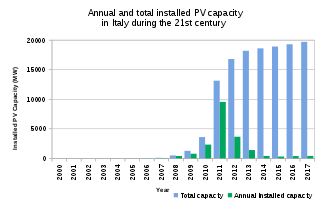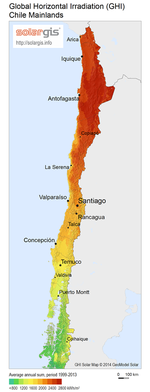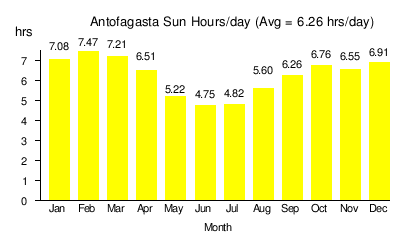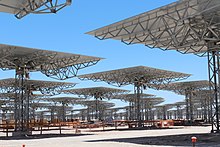
Many countries and territories have installed significant solar power capacity into their electrical grids to supplement or provide an alternative to conventional energy sources. Solar power plants use one of two technologies:

Hybrid power are combinations between different technologies to produce power.

Spain is one of the first countries to deploy large-scale solar photovoltaics, and is the world leader in concentrated solar power (CSP) production.

Renewable energy in Spain, comprising bioenergy, wind, solar, and hydro sources, accounted for 15.0% of the Total Energy Supply (TES) in 2019. Oil was the largest contributor at 42.4% of the TES, followed by gas, which made up 25.4%.
SolarReserve was a developer of utility-scale solar power projects which include Concentrated Solar Power (CSP) and Photovoltaic (PV) technology. The company has commercialized solar thermal energy storage technology that enables solar power tower CSP plants to deliver electricity day and night. In this technology, a molten salt is used to capture the energy from the sun and store it. When electricity is needed, the stored liquid salt is used to turn water into steam to turn a turbine and generate electricity.

Solar power has been growing rapidly in the U.S. state of California because of high insolation, community support, declining solar costs, and a renewable portfolio standard which requires that 60% of California's electricity come from renewable resources by 2030, with 100% by 2045. Much of this is expected to come from solar power via photovoltaic facilities or concentrated solar power facilities.

The energy sector in Hawaii has rapidly adopted solar power due to the high costs of electricity, and good solar resources, and has one of the highest per capita rates of solar power in the United States. Hawaii's imported energy costs, mostly for imported petroleum and coal, are three to four times higher than the mainland, so Hawaii has motivation to become one of the highest users of solar energy. Hawaii was the first state in the United States to reach grid parity for photovoltaics. Its tropical location provides abundant ambient energy.

Enel Green Power S.p.A. is an Italian multinational renewable energy corporation, headquartered in Rome. The company was formed as a subsidiary of the power generation firm Enel in December 2008. It has operations in five continents generating energy from solar, geothermal, wind and hydropower sources. As of 2022, it manages a capacity of 60,9 GW and has over 1200 plants worldwide.

Solar power is an important contributor to electricity generation in Italy, accounting for 8% of the total in 2017. As of 2022, the country has a total installed capacity of 22.56 GW. In 2019, Italy set a national goal of reaching 50 GW by 2030.

Renewable energy has developed rapidly in Italy over the past decade and provided the country a means of diversifying from its historical dependency on imported fuels. Solar power accounted for around 8% of the total electric production in the country in 2014, making Italy the country with the highest contribution from solar energy in the world that year. Rapid growth in the deployment of solar, wind and bio energy in recent years lead to Italy producing over 40% of its electricity from renewable sources in 2014.

A photovoltaic power station, also known as a solar park, solar farm, or solar power plant, is a large-scale grid-connected photovoltaic power system designed for the supply of merchant power. They are different from most building-mounted and other decentralized solar power because they supply power at the utility level, rather than to a local user or users. Utility-scale solar is sometimes used to describe this type of project.

Solar power in Mexico has the potential to produce vast amounts of energy. 70% of the country has an insolation of greater than 4.5 kWh/m2/day. Using 15% efficient photovoltaics, a square 25 km (16 mi) on each side in the state of Chihuahua or the Sonoran Desert could supply all of Mexico's electricity.

Solar power in Florida has been increasing, as the cost of solar power systems using photovoltaics (PV) has decreased in recent years. Florida has low electricity costs compared with other states, which makes individual solar investment less attractive. Florida ranks ninth nationally in solar resource strength according to the National Renewable Energy Laboratory and tenth in solar generation by the Solar Energy Industries Association.

Solar power in South Africa includes photovoltaics (PV) as well as concentrated solar power (CSP). As of 2023, South Africa had over 2700 MW of installed PV solar power capacity in its grid, in addition to 500 MW of CSP. Installed capacity is expected to reach 8,400 MW by 2030.
The Stillwater GeoSolar Hybrid Plant is a combined 61 MW solar energy and geothermal power plant in the U.S. state of Nevada. Located 12 miles (19 km) NE of Fallon, near Stillwater, the site includes a 26MW solar photovoltaic plant and a 2MW solar thermal plant that were added to a 33MW geothermal plant.

Cerro Dominador Solar Power Plant is a 210-megawatt (MW) combined concentrated solar power and photovoltaic plant located in the commune of María Elena in the Antofagasta Region of Chile, about 24 kilometres (15 mi) west-northwest of Sierra Gorda. The project was approved by the Chilean government in 2013 and construction was started by Abengoa Solar Chile, a branch of the multinational Abengoa Spain. The plant was inaugurated on June 8, 2021. A follow-up project called Likana Solar bid $33.99/MWh in an auction in August 2021.
Mount Signal Solar, also known as Imperial Valley Solar Project, is a 794 MWp (614 MWAC) photovoltaic power station west of Calexico, California, United States, in the southern Imperial Valley, near the Mexican border. The facility is being developed and constructed by 8minutenergy Renewables in three phases, with two completed as of 2018. At full build-out, it will be one of the world's largest PV solar farms with a capacity of about 800 MWp (600 MWAC). The project has been supported by several environmental groups, as the power station was built on low productivity farmland.
Renewable energy in Chile is classified as Conventional and Non Conventional Renewable Energy (NCRE), and includes biomass, hydro-power, geothermal, wind and solar among other energy sources. Usually, when referring to Renewable Energy in Chile, it will be the Non Conventional kind.
The Copiapó Solar Project is a 390 megawatt (MW) net solar thermal power project to be located near Copiapó, about 65 kilometers east of the coastal town of Caldera. The project is being developed by SolarReserve, and is scheduled to reach commercial operation in 2019.

















